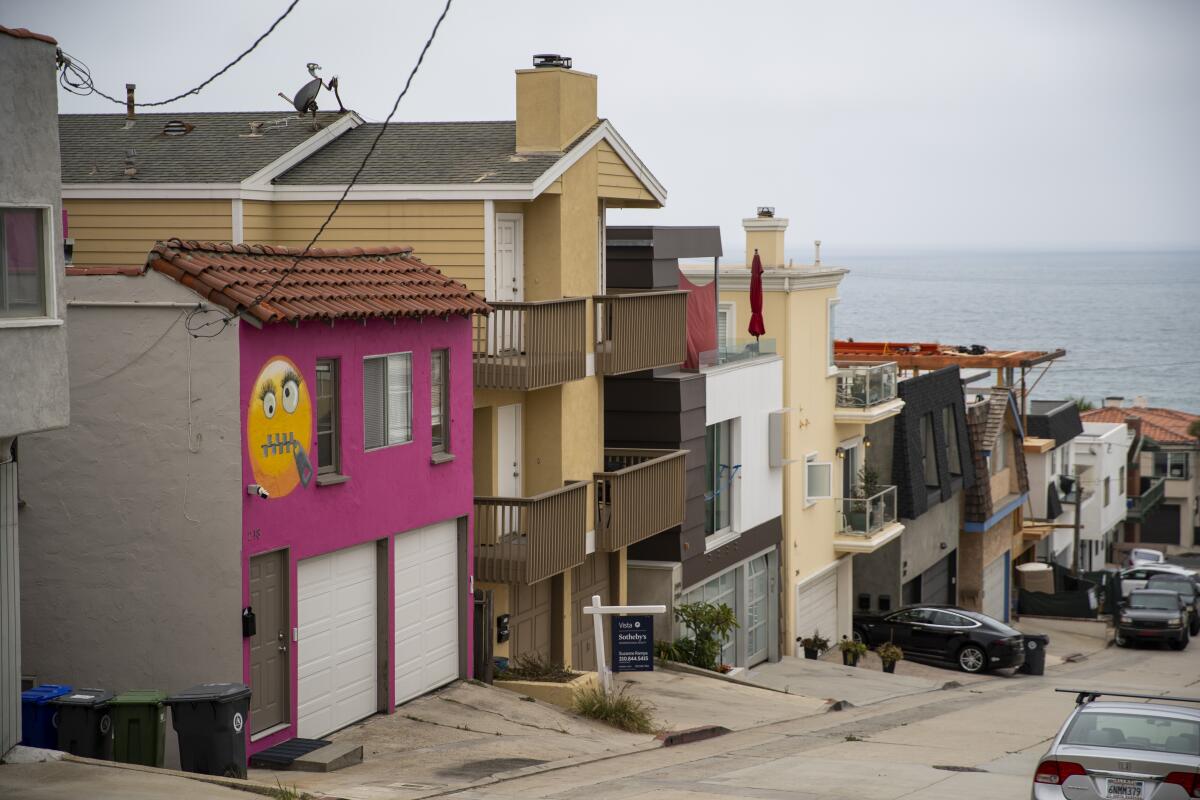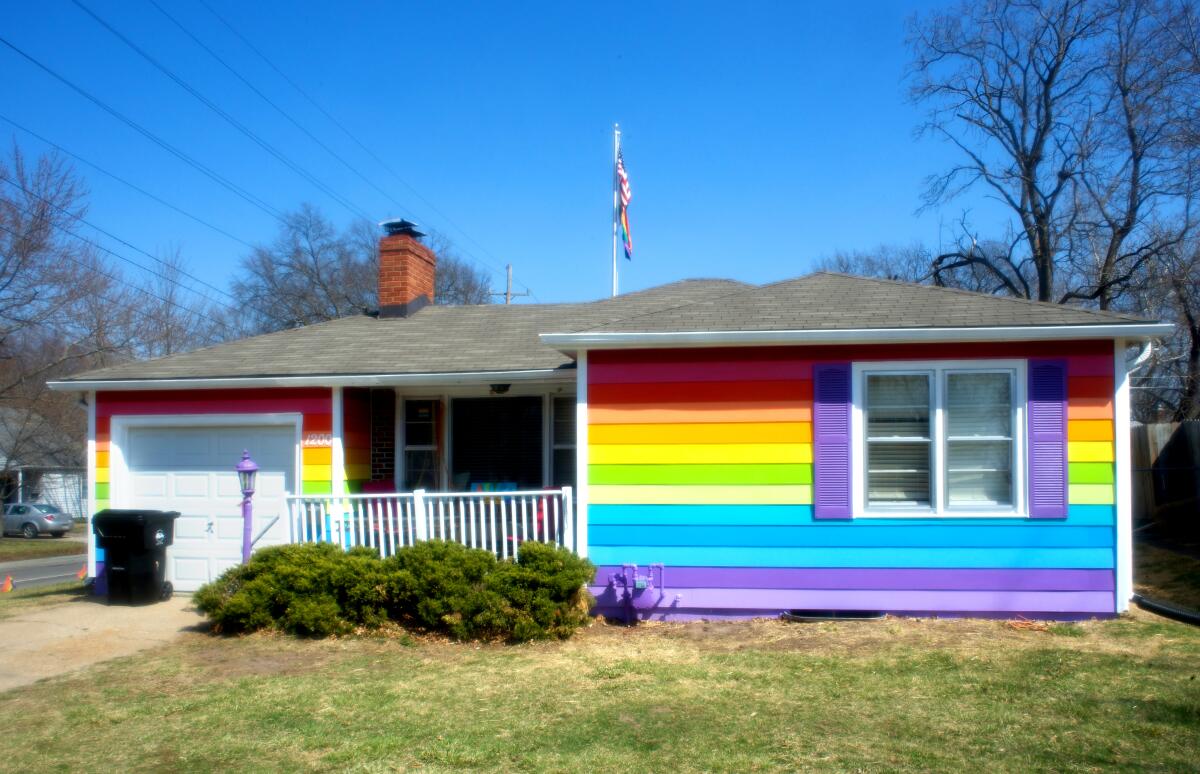Startled by Manhattan Beach’s emoji house? Let me tell you about spite houses and my lunch in Sarajevo

- Share via
Naturally, when I heard of the brouhaha in Manhattan Beach over a house that’s suddenly pink and dotted with bold emojis, I thought of Sarajevo in Bosnia and Herzegovina.
More specifically, I flashed back to the House of Spite, just south of the Miljacka River, where I had a splendid lunch back in 2014.
Spite houses, you see, are a thing. They are the subject of Atlas Obscura entries, a photo gallery on Curbed, a rumination in the New York Times and many a discovery by tourists seeking local color. And these houses seem to have been a thing as long as there have been ill-suited neighbors, or siblings, or spouses.
Some are designed to block views, some to block sunlight or a road, some to satisfy more obscure grudges. Some spite is structural, sometimes it’s only skin-deep and sometimes, perhaps, it’s just in the eye of the beholder.
The issue in Manhattan Beach was vacation rentals: The city, alerted by neighbors, has fined property owner Kathryn Kidd for violating a Manhattan Beach law against renting out properties on a short-term basis. Then the emoji-laden paint job appeared. Then came coverage by the local Easy Reader News, the L.A. Times and many others.
“Instead of everybody being so gloomy, always so depressed, always in other people’s business, I just wanted to send a message to be happy, be colorful, be positive and enjoy,” the Easy Reader News quoted Kidd as saying. Hmm.
It’s entirely possible to spend hours or days chasing spite-house stories and images across the internet. (I can testify to this.) But I’m going to give you just four more here, beginning with that restaurant on the river.
Minced meat in the House of Spite

In Sarajevo, the House of Spite (Inat Kuća, in the Bosnian language) began its life as a private home, just north of the river. But once Austro-Hungarian authorities gained control of the region, they wanted to level the home as part of a plan in the 1890s to build a new neo-Moorish City Hall in grand style.
Only problem: The old man who owned the house, known as Benderija, wouldn’t sell. Thus the civic project seemed doomed until the authorities sweetened the pot, literally paying the man with a bag of gold and agreeing to dismantle his house, move it across the River Miljacka, then put it back together, brick by brick. As the story is told, the old man enjoyed the view, watching day after day from a nearby bridge as the house was transferred.
City Hall was completed, survived World War I (which began a few blocks away), was converted into a library, was almost entirely destroyed in the Bosnian War of the early 1990s, then was rebuilt over two decades.
Benderija’s old house survived all of that strife, too, and in 1997 was converted into a restaurant. As a result, diners today at the House of Spite have a pleasant view across the river of the grand old City Hall, now a library and museum. Some Trip Advisor diners give the restaurant mixed reviews, but I did enjoy my minced-meat lunch there.
In Seattle, is this a malicious erection?
In the Seattle neighborhood of Montlake, a spat between two neighbors in the 1920s led one of them to put up a strange, skinny, pie-shaped house, just 4 ½ feet wide at the back, 15 feet in front, about 860 square feet in all. When it was up for sale in 2013, local news station KOMO did a story about its strange history, as did Curbed when it was briefly offered last year for a shade under $600,000.
Accounts differ about the precise origin of spite in this case (local folklore mentions a divorce) but all parties seem to agree that one neighbor was doing his or her best to annoy the bejabbers out of another. Also, an Oregonian reporter noted that the home would appear to be covered by a Washington state law governing “malicious erection.”
In Kansas, spite of a different hue

In Topeka, Kansas, Equality House puts a different sort of spin on spite. It’s a rainbow-colored structure bought and painted by LGBT activists to defy the gay-hating Westboro Baptist Church across the street.
In Massachusetts, loneliness and bad plumbing
In New England, spite house-building seems to be a long-standing and thriving industry — here’s a round-up of five such structures, dating to 1715. One of them stands out rather literally.
The Pink House of Newbury, Mass., was built in 1922, or maybe 1925. According to local lore, a separating couple made a pact that the husband would build for the wife an exact replica of their current home. But the wife didn’t specify where it would go — so the ex-husband-to-be put it alone in the middle of a marsh (now the Park River National Wildlife Refuge) and didn’t bother to provide for fresh running water.
All these years later it remains, forlorn, idle and crying out to be painted by Edward Hopper, if only he were alive. As of last year, the house was owned by the wildlife refuge. But some folks dream of a land swap that could make the building livable again.
In the meantime, you can’t go inside, or even onto the property, but you can admire it from the shoulder of the Plum Island Turnpike. And every once in a while, someone gets permission to touch up that pink paint.
All it lacks, really, is a few emojis.
More to Read
Sign up for The Wild
We’ll help you find the best places to hike, bike and run, as well as the perfect silent spots for meditation and yoga.
You may occasionally receive promotional content from the Los Angeles Times.







